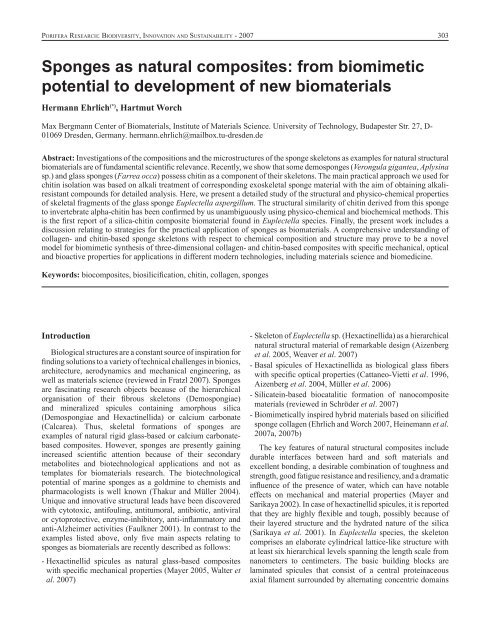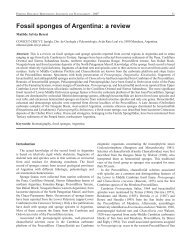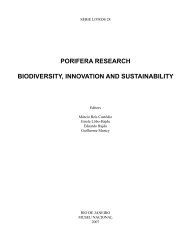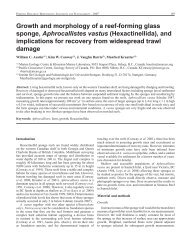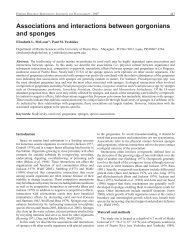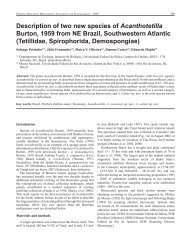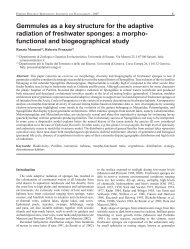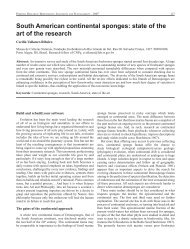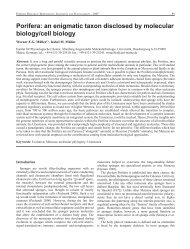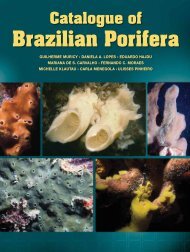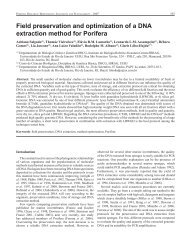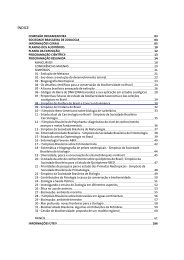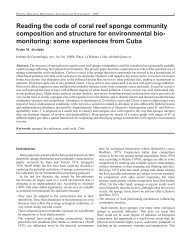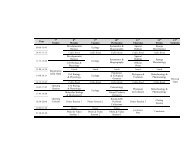Sponges as natural composites.pdf - Porifera Brasil
Sponges as natural composites.pdf - Porifera Brasil
Sponges as natural composites.pdf - Porifera Brasil
Create successful ePaper yourself
Turn your PDF publications into a flip-book with our unique Google optimized e-Paper software.
<strong>Porifera</strong> Research: Biodiversity, Innovation and Sustainability - 2007303<strong>Sponges</strong> <strong>as</strong> <strong>natural</strong> <strong>composites</strong>: from biomimeticpotential to development of new biomaterialsHermann Ehrlich (*) , Hartmut WorchMax Bergmann Center of Biomaterials, Institute of Materials Science. University of Technology, Budapester Str. 27, D-01069 Dresden, Germany. hermann.ehrlich@mailbox.tu-dresden.deAbstract: Investigations of the compositions and the microstructures of the sponge skeletons <strong>as</strong> examples for <strong>natural</strong> structuralbiomaterials are of fundamental scientific relevance. Recently, we show that some demosponges (Verongula gigantea, Aplysin<strong>as</strong>p.) and gl<strong>as</strong>s sponges (Farrea occa) possess chitin <strong>as</strong> a component of their skeletons. The main practical approach we used forchitin isolation w<strong>as</strong> b<strong>as</strong>ed on alkali treatment of corresponding exoskeletal sponge material with the aim of obtaining alkaliresistantcompounds for detailed analysis. Here, we present a detailed study of the structural and physico-chemical propertiesof skeletal fragments of the gl<strong>as</strong>s sponge Euplectella <strong>as</strong>pergillum. The structural similarity of chitin derived from this spongeto invertebrate alpha-chitin h<strong>as</strong> been confirmed by us unambiguously using physico-chemical and biochemical methods. Thisis the first report of a silica-chitin composite biomaterial found in Euplectella species. Finally, the present work includes adiscussion relating to strategies for the practical application of sponges <strong>as</strong> biomaterials. A comprehensive understanding ofcollagen- and chitin-b<strong>as</strong>ed sponge skeletons with respect to chemical composition and structure may prove to be a novelmodel for biomimetic synthesis of three-dimensional collagen- and chitin-b<strong>as</strong>ed <strong>composites</strong> with specific mechanical, opticaland bioactive properties for applications in different modern technologies, including materials science and biomedicine.Keywords: bio<strong>composites</strong>, biosilicification, chitin, collagen, spongesIntroductionBiological structures are a constant source of inspiration forfinding solutions to a variety of technical challenges in bionics,architecture, aerodynamics and mechanical engineering, <strong>as</strong>well <strong>as</strong> materials science (reviewed in Fratzl 2007). <strong>Sponges</strong>are f<strong>as</strong>cinating research objects because of the hierarchicalorganisation of their fibrous skeletons (Demospongiae)and mineralized spicules containing amorphous silica(Demospongiae and Hexactinellida) or calcium carbonate(Calcarea). Thus, skeletal formations of sponges areexamples of <strong>natural</strong> rigid gl<strong>as</strong>s-b<strong>as</strong>ed or calcium carbonateb<strong>as</strong>ed<strong>composites</strong>. However, sponges are presently gainingincre<strong>as</strong>ed scientific attention because of their secondarymetabolites and biotechnological applications and not <strong>as</strong>templates for biomaterials research. The biotechnologicalpotential of marine sponges <strong>as</strong> a goldmine to chemists andpharmacologists is well known (Thakur and Müller 2004).Unique and innovative structural leads have been discoveredwith cytotoxic, antifouling, antitumoral, antibiotic, antiviralor cytoprotective, enzyme-inhibitory, anti-inflammatory andanti-Alzheimer activities (Faulkner 2001). In contr<strong>as</strong>t to theexamples listed above, only five main <strong>as</strong>pects relating tosponges <strong>as</strong> biomaterials are recently described <strong>as</strong> follows:- Hexactinellid spicules <strong>as</strong> <strong>natural</strong> gl<strong>as</strong>s-b<strong>as</strong>ed <strong>composites</strong>with specific mechanical properties (Mayer 2005, Walter etal. 2007)- Skeleton of Euplectella sp. (Hexactinellida) <strong>as</strong> a hierarchical<strong>natural</strong> structural material of remarkable design (Aizenberget al. 2005, Weaver et al. 2007)- B<strong>as</strong>al spicules of Hexactinellida <strong>as</strong> biological gl<strong>as</strong>s fiberswith specific optical properties (Cattaneo-Vietti et al. 1996,Aizenberg et al. 2004, Müller et al. 2006)- Silicatein-b<strong>as</strong>ed biocatalitic formation of nanocompositematerials (reviewed in Schröder et al. 2007)- Biomimetically inspired hybrid materials b<strong>as</strong>ed on silicifiedsponge collagen (Ehrlich and Worch 2007, Heinemann et al.2007a, 2007b)The key features of <strong>natural</strong> structural <strong>composites</strong> includedurable interfaces between hard and soft materials andexcellent bonding, a desirable combination of toughness andstrength, good fatigue resistance and resiliency, and a dramaticinfluence of the presence of water, which can have notableeffects on mechanical and material properties (Mayer andSarikaya 2002). In c<strong>as</strong>e of hexactinellid spicules, it is reportedthat they are highly flexible and tough, possibly because oftheir layered structure and the hydrated nature of the silica(Sarikaya et al. 2001). In Euplectella species, the skeletoncomprises an elaborate cylindrical lattice-like structure withat le<strong>as</strong>t six hierarchical levels spanning the length scale fromnanometers to centimeters. The b<strong>as</strong>ic building blocks arelaminated spicules that consist of a central proteinaceousaxial filament surrounded by alternating concentric domains
304of consolidated silica nanoparticles and organic interlayers(Weaver et al. 2007).There is no doubt that some of the b<strong>as</strong>al spicules ofhexactinellid sponges or fibrous skeletons of demospongesare remarkable for their size, durability, flexibility and theiroptical properties, a set of features rendering them of interest<strong>as</strong> bio<strong>composites</strong> with high biomimetic potential. Of course,the materials science <strong>as</strong>pects of sponges can be studied bymodel systems, and utilized for biomimetic engineering.However, we cannot mimic nature with a view to designingnovel biomaterials without knowledge of the nature andorigin of the organic matrices of corresponding <strong>natural</strong>bio<strong>composites</strong> which are present in sponges. Therefore, thebiggest shortcoming common to all publications relatingto mechanical, structural and optical properties of spongeskeletal formations is a lack of real information regarding thechemical nature of corresponding organic matrices.The finding of collagen within b<strong>as</strong>al spicules of tworepresentatives of Hexactinellida, Hyalonema sieboldiand Monorhaphis chuni (Ehrlich et al. 2005a), <strong>as</strong> well <strong>as</strong>the occurrence of chitin within the framework skeleton ofFarrea occa (Ehrlich et al. 2007a), <strong>as</strong> revealed by gentledesilicification in alkali, stimulated further attempts tosearch for materials of organic nature in other gl<strong>as</strong>s sponges.Consequently, the objective of the current study w<strong>as</strong> to testthe hypothesis that chitin is an essential component of thesilica spicules of Euplectella <strong>as</strong>pergillum <strong>as</strong> well, and if so, tounravel its involvement in the mechanical behaviour of thesespicules, which w<strong>as</strong> recently well investigated (Walter et al.2007, Weaver et al. 2007). We decided to re-examine alsothe results of some previously reported studies concerning thepresence of polysaccharides within silica-containing spiculesof this sponge. For example, Travis et al. (1967) reported thepresence of parallel-oriented cellulose-like filaments with anaverage width of 1.9 nm observed in organic matrix materialafter HF-b<strong>as</strong>ed desilicification of the spicules of hexactinellidEuplectella sp. These matrices also contained considerableamounts of hexosamine.Finally, the present work includes a discussion relatingto strategies for the practical application of sponges <strong>as</strong>biomaterials.Materials and methodsChemical etching of gl<strong>as</strong>s sponge skeletonsThe object of our study w<strong>as</strong> Euplectella <strong>as</strong>pergillum(Hexactinellida: <strong>Porifera</strong>), collected in 2005 in thePacific Ocean (Philippines). Additionally, the followingrepresentatives of Hexactinellida sponges: Hyalonem<strong>as</strong>ieboldi, Monorhaphis chuni, Aphrocallistes v<strong>as</strong>tus andFarrea occa were investigated <strong>as</strong> comparisons to obtainpreliminary results relating to differences in the resistance ofthese species to alkali treatment. Skeletons of these spongeswere treated similarly and according to the procedure thatfollows <strong>as</strong> described below for E. <strong>as</strong>pergillum. The durationof the desilicification period w<strong>as</strong> the time required to dissolve50% of the silica. Silicon concentrations were determinedby the silicomolybdate method (Iler 1979) according to USStandard Methods 4500-Si E using Silicat (Kieselsäure)-Test(Merck).Skeletons of E. <strong>as</strong>pergillum were treated according tothe following procedure. Sponge material of E. <strong>as</strong>pergillumw<strong>as</strong> stored for several days in fresh sea-water. The spongew<strong>as</strong> dried afterwards for 4 days at 45°C. Finally the spongeskeleton w<strong>as</strong> cleaned in 10% H 2O 2and dried again at 45°C.Tissue-free dried sponge material w<strong>as</strong> w<strong>as</strong>hed three timesin distilled water, cut into 3 cm long pieces and placed ina solution containing purified Clostridium histolyticumcollagen<strong>as</strong>e (Sigma) to digest any possible collagencontamination of exogenous nature. After incubation for24h at 15°C, the pieces of gl<strong>as</strong>s sponge skeleton were againw<strong>as</strong>hed three times in distilled water, dried and placed in a 15ml vessel containing chitin<strong>as</strong>e solution (<strong>as</strong> described below)to digest any possible exogenous chitin contaminations. Afterincubation for 48h at 25°C, fragments of skeleton were againw<strong>as</strong>hed, dried and placed in 10 ml pl<strong>as</strong>tic vessel containing 8ml 2.5 M NaOH solution. The vessel w<strong>as</strong> covered and placedunder thermostatic conditions at 37°C without shaking.The effectiveness of the alkali etching w<strong>as</strong> also monitoredusing optical and scanning electron microscopy (SEM) atdifferent locations along the length of the spicular materialand within the cross-sectional area. The colourless alkaliinsolublematerial obtained after alkali treatment of thegl<strong>as</strong>s sponge samples w<strong>as</strong> w<strong>as</strong>hed with distilled water fivetimes and finally dialysed against deionized water on Roth(Germany) membranes with a MWCO of 14 kDa. Dialysisw<strong>as</strong> performed for 5 days at 4°C. The dialyzed material w<strong>as</strong>dried at room temperature and used for staining and analyticalinvestigations.Staining and detection of chitinWe used Calcofluor White (Fluorescent Brightener M2R,Sigma) which shows enhanced fluorescence when it bindsto chitin (Pringle 1991). The pieces of <strong>natural</strong> gl<strong>as</strong>s spongeskeleton samples and those which were subjected to alkalitreatment were placed in 0.1 M Tris-HCl, pH 8.5 for 30 min.After this procedure they were stained using 0.1% CalcofluorWhite solution for 30 min in darkness, rinsed three timeswith distilled water, dried at room temperature and finallyinvestigated using Wide Field Fluorescence <strong>as</strong> well <strong>as</strong>confocal L<strong>as</strong>er Scanning Microscopy (LSM) (Zeiss LSM 510META). For LSM, the fluorescence of Calcofluor White w<strong>as</strong>excited by a NIR pulsed l<strong>as</strong>er (770 nm) using two-photonexcitation.This corresponds to a single-photon-excitation atapproximately 380 nm that yields a fluorescence emission at440 nm.FTIR spectroscopyIR spectra were recorded with a Perkin Elmer FTIRSpectrometer Spectrum 2000, equipped with an AutoImageMicroscope using the FT-IRRAS technique (FourierTransform Infrared Reflection Absorption Spectroscopy).
X-ray analysisX-ray diffraction me<strong>as</strong>urements were performed by aSTOE-STUDIP-MP diffractometer with Ge-monochromatorat Cu kα1wave length.Transmission electron microscopy (TEM)Conventional transmission electron microscopy w<strong>as</strong>performed with a Philips CM200 FEG\ST Lorentz electronmicroscope at an acceleration voltage of 200 kV. For electronmicroscopy, a drop of the water suspension containing thesample w<strong>as</strong> placed onto the electron microscopy grid. Afterone minute, the excess w<strong>as</strong> removed using blotting paper andthereafter dried in air. The electron microscopy grids (Plano,Germany) were covered with a holey carbon film.Fluorescence and confocal l<strong>as</strong>er scanning microscopyFor both methods an upright light microscope Axioscope 2FS mot w<strong>as</strong> used. For LSM, it w<strong>as</strong> equipped with a Zeiss LSM510 META scanning head. Fluorescence w<strong>as</strong> excited eitherby a mercury arc lamp HBO50 or, in the c<strong>as</strong>e of LSM, by Ar+ion- (488 nm), He/Ne- (546 nm) and Titanium/Sapphire-NIR(770 nm) l<strong>as</strong>ers. The spectra were recorded by the METAspectrograph inside the scanning head.SEM analysisThe samples were fixed in a sample holder and coveredwith carbon, or with a gold layer for 1 min using an EdwardsS150B sputter coater. The samples were then placed in anESEM XL 30 Philips or LEO DSM 982 Gemini scanningelectron microscope.Chitin<strong>as</strong>e digestion and testDried 20 mg samples of sponge skeleton, previouslypulverized to a fine powder in an agat mortar, were suspendedin 400 µl of 0.2 M phosphate buffer at pH 6.5. Positive controlw<strong>as</strong> prepared by solubilizing 0.3% colloidal chitin in the samebuffer. Equal amounts of 1 mg/ml of three chitin<strong>as</strong>es (EC3.2.1.14 and EC 3.2.1.30): N-acetyl-β-glucosaminid<strong>as</strong>e fromTrichoderma viride, Sigma, No. C-8241, and two Poly (1,4-β-[2-acetamido-2-deoxy-D-glucoside])glycanohydrol<strong>as</strong>es fromSerratia marcescens, Sigma, No. C-7809 and Streptomycesgriseus, Sigma, No. C-6137 respectively, were suspendedin 100 mM sodium phosphate buffer at pH 6.0. Digestionw<strong>as</strong> started by mixing 400 µl of the samples and 400 µl ofthe chitin<strong>as</strong>e-mix. Incubation w<strong>as</strong> performed at 37°C andstopped after 114 h by adding 400 µl of 1% NaOH, followedby boiling for 5 min. The effectiveness of the enzymaticdegradation w<strong>as</strong> monitored using optical microscopy (Zeis,Axiovert). The Morgan-Elson <strong>as</strong>say w<strong>as</strong> used to quantifythe N-acetylglucosamie rele<strong>as</strong>ed after chitin<strong>as</strong>e treatment <strong>as</strong>described previously (Boden et al. 1985). The sample whichcontains chitin<strong>as</strong>e solution without substrate w<strong>as</strong> used <strong>as</strong> acontrol.Preparation of α -Chitin305Alpha-Chitin w<strong>as</strong> prepared from a commercially availablecrab shell chitin (Fluka). The material w<strong>as</strong> purified withaqueous 1 M HCl for 2 h at 25°C and then refluxed in 2 MNaOH for 48h at 25°C. The resulting α-chitin w<strong>as</strong> w<strong>as</strong>hedin deionized water by several centrifugations until neutralityw<strong>as</strong> reached. The whole procedure w<strong>as</strong> repeated twice.Preparation of colloidal chitinTen grams of α-chitin (Fluka) w<strong>as</strong> mixed with 500 mlof 85% phosphoric acid and stirred for 24h at 4°C. Thesuspension w<strong>as</strong> poured into 5 litres of distilled water (DW) andcentrifuged (15000 x g for 15 min). The resulting precipitatew<strong>as</strong> w<strong>as</strong>hed with DW until the pH reached 5.0 and thenneutralized by addition of 6 N NaOH. The suspension w<strong>as</strong>centrifuged (15000 x g for 15 min) and w<strong>as</strong>hed with 3 litresof DW for desalting. The resulting precipitate w<strong>as</strong> suspendedin DW and dialyzed. The chitin content in the suspension w<strong>as</strong>determined by drying a sample.Silicification of colloidal chitinIn the first step, 0.93 g of colloidal chitin previouslysuspended in 34.6 g of methanol w<strong>as</strong> added to 51.8 ml ofdeionized water. The suspension pH w<strong>as</strong> then raised above 10with the addition of 100 µL of 1 N NaOH solution. Finally,169 µL of tetramethylorthosilicate (TMOS, 99 wt%) wereadded and the solution stirred at room temperature. After 1h the suspension w<strong>as</strong> filtered and the recovered precipitaterinsed with water, then with methanol and finally air-dried.Results and discussionSpecies of the cl<strong>as</strong>s Hexactinellida are found in alloceans, and live at depths from 30 to 6235 m (Reiswig2004). The gl<strong>as</strong>s sponges of the families Hyalonematidae,Monorhaptidae, Pheronematidae and, to a certain extent,Euplectellidae inhabit loose muddy substrates. One of thestrategies of survival under such conditions is the formationof root like structures that prevent the body of the animalfrom sinking into the ground (Tabachnik 1991). In contr<strong>as</strong>tto demosponges, where the cytoskeleton is organised onthe b<strong>as</strong>is of individual cells, in hexactinellids it provides <strong>as</strong>upporting framework and transport pathways within v<strong>as</strong>t,multinucleate tissue m<strong>as</strong>ses (Leys 1995). It w<strong>as</strong> suggestedthat hexactinellid sponges may have evolved from cellularsponges and that syncytial tissues are not a primitive trait ofthe Metazoa (Leys 2002). Due to their preferred deep-seahabitat, the Hexactinnellida have been poorly investigatedwith respect to their general biology (Reiswig and Mehl1991) and the nature of organic components which buildtheir skeletal structures. It w<strong>as</strong> generally accepted that theirskeletons are composed of amorphous hydrated silica (de LaRocha 2003) deposited around a proteinaceous axial filament(Uriz et al. 2003, Weaver and Morse 2003, Weaver et al.2007).The resolution of the question: how to isolate theorganic matrix from the silica containing sponge skeleton,is absolutely dependent on the desilicification method. Up
306to now, the common technique for the demineralization ofgl<strong>as</strong>s sponge spicules and skeletons w<strong>as</strong> b<strong>as</strong>ed on hydrogenfluoride solutions (Uriz et al. 2003). However, the HF-b<strong>as</strong>edsilica dissolution procedure w<strong>as</strong> criticised <strong>as</strong> being a ratheraggressive chemical procedure which could dr<strong>as</strong>ticallychange the structure of the organic matrix (Travis et al. 1967,Croce et al. 2004, Ehrlich et al. 2005b, 2005c). To overcomethis obstacle, we developed novel, slow-etching methodswhich use a solution of 2.5 M NaOH at 37°C and take 14days or more (Ehrlich et al. 2005a, 2005b, 2005c, 2006).This type of biosilica dissolution is practically impossible inwell-crystallized silica such <strong>as</strong> quartz, but is much strongerin amorphous silica because of the incre<strong>as</strong>ed surface area anddisordered, open lattice structure. Thus the main practicalapproach we used w<strong>as</strong> b<strong>as</strong>ed on alkali treatment of thecorresponding exoskeletal gl<strong>as</strong>s sponge material with the aimof obtaining alkali-resistant material for detailed analyseswith respect to its identification.Chitin within skeletal formations of E. <strong>as</strong>pergillumThe finding of collagen within b<strong>as</strong>al spicules of H. sieboldiand M. chuni (Ehrlich et al. 2005a, 2005b, 2005c, 2006) aftertheir desilicification using alkali treatment during 7-30 days,stimulated our attempts to find materials of organic naturein other species of gl<strong>as</strong>s sponges. Thus, we started similardemineralization experiments with skeletons of E. <strong>as</strong>pergillum(Fig. 1), A. v<strong>as</strong>tus and F. occa. However, we have not observedany visible signs of demineralization of these materials usingoptical microscopy and SEM after the same time elapsedand at the similar experimental conditions <strong>as</strong> in the studyon H. sieboldi and M. chuni. On the contrary, fragmentsof skeletons of E. <strong>as</strong>pergillum, A. v<strong>as</strong>tus and F. occa showhigh resistance to alkali treatment even after some months ofTable 1: Comparison of desilicification duration relating to differentrepresentatives of Hexactinellida.Species of HexactinellidaMonorhaphis chuniHyalonema sieboldiEuplectella <strong>as</strong>pergillumAphrocallistes v<strong>as</strong>tusFarrea occaDuration of desilicification3-10 days14-30 days4-6 months6-8 months6-12 monthsdemineralization (Table 1). This phenomenon led us to the<strong>as</strong>sumption that siliceous skeletons of investigated spongespossess a biomaterial which protects amorphous silica fromdissolution in alkali, and is highly resistant to alkali digestion.It is well known that chitin in alkali is stable with respectto degradation (Einbu et al. 2004). Correspondingly, in ourexperiments, chitin w<strong>as</strong> the first candidate for a biomaterialwith this property.Scanning electron microscopy (SEM) investigations ofthe <strong>natural</strong> tissue-free skeleton of E. <strong>as</strong>pergillum (Fig. 1A)confirmed their framework structure, typical for Euplectell<strong>as</strong>pecies (Weaver et al. 2007).Alkali treatment of the same skeleton samples led toloss of integrity. Figs. 2A and 2B show a typical view of apartially demineralised gl<strong>as</strong>s sponge skeleton obtained afterdemineralization. Desilicification of E. <strong>as</strong>pergillum skeletonsw<strong>as</strong> definitively effective within this structural formation:alkali treatment leads to loss of the interior layers of thespicule, causing the spicules to become twisted (Fig. 2B).In contr<strong>as</strong>t to alkali-resistant spicules, alkali-etched junctionare<strong>as</strong> (Fig. 2C) show that the silica-b<strong>as</strong>ed cement-like latticeFig. 1: A. Micrograph of E. <strong>as</strong>pergillum siliceous tissue-free skeleton. B. SEM image of spicules which build the square-grid lattice ofvertical and horizontal struts typical for the skeleton of this hexactinellid.
307Fig. 2: SEM images: A. E. <strong>as</strong>pergillum skeleton after alkali treatment (6 months). B. Desilicification leads to loss of the interior layers ofthe spicule, causing it to become twisted. C, D. Alkali-etched junctions show that the silica-b<strong>as</strong>ed cement-like lattice is strongly corrodedin contr<strong>as</strong>t to alkali-resistant spicules.is corroded (Fig. 2D). Corrosion and subsequent dissolutionof silica-containing cement might be the main re<strong>as</strong>on forthe collapse of the mechanically stable and hierarchicallyconstructed skeleton of Euplectella, for which the intactsponge is well-known.To test our hypothesis that alkali-insoluble residues of E.<strong>as</strong>pergillum skeletons are of a chitinous nature, we stainedthem with Calcoflour White and investigated them usingfluorescence microscopy. Wide fluorescence microscopyimages of <strong>natural</strong> gl<strong>as</strong>s sponge skeleton treated with alkaliand stained with Calcofluor White revealed that chitin isdistributed on and within the outermost layer of these skeletalstructures (Fig. 3A). The characteristic blue fluorescenceof stained chitin within partially desilicified gl<strong>as</strong>s spongeskeletons (Fig. 3B) led us to the <strong>as</strong>sumption that it mightoriginally be involved in the phenomenon of biosilificationand act <strong>as</strong> a center of silica nanoparticle nucleation.Chitin, or poly [ß(1→4)-2-acetamido-2-deoxy-Dglucopyranose],is crystalline in its native state (Minke andBlackwell 1969) in contr<strong>as</strong>t to amorphous silicon dioxideof biogenic origin. This property determined correspondingstructural investigations.The overview TEM micrograph of Fig. 4A shows a chitinresidue after demineralization of the skeleton sample. In theFourier Transformation of the high-resolution micrographsthe spacings of 4.85 Å, 4.42 Å, 2.95 Å, 2.54 Å could bedetected corresponding to (100), (200), (105) and (106) (Fig.4B) reflections proving the orthorhombic structure typical forα-chitin <strong>as</strong> described in detail by Carlström (1957).The results of the additional physico-chemical analysisperformed using FTIR, Raman and XRD (data not shown)were similar to those from F. occa (Ehrlich et al. 2007a) andfrom keratose sponges (Ehrlich et al. 2007b). Therefore, allanalysis listed above indicate without ambiguity that thematerial isolated from E. <strong>as</strong>pergillum skeleton is α-chitin,further confirming our earlier observations that chitinsin marine sponges appear to be consistently in the alphamodification.
308Fig. 3: A. Wide field fluorescence microscopy image exhibiting strong evidence of the presence of chitin after Calcofluor White stainingof an alkali-resistant twisted spicule which lost its content during desilicification. B. 3D reconstruction of a confocal LSM image stack (70single images) showing Calcofluor White fluorescence in the outermost region of the twisted spicule.The analysis of chitin within gl<strong>as</strong>s sponge skeletalmaterial using enzymatic methods is quite difficult, which isunderlined by the fact that chitin is bound to silica and that thecorresponding enzyme must gain sufficient access to attackthe surface of the substrate. Therefore, corresponding skeletonsamples of E. <strong>as</strong>pergillum were mechanically disrupted beforeenzymatic treatment started. We used a chitin<strong>as</strong>e digestiontest for chitin identification on and within the investigatedhexactinellid millimeter-large skeleton fragments. It isknown that chitinolytic systems in nature comprise of anendochitin<strong>as</strong>e, chitobi<strong>as</strong>e and an exochitin<strong>as</strong>e, whose actionsmay be synergistic and consecutive in the degradation ofchitin to free N-acetyl glucosamine (Gohel et al. 2006). Toquantify chitin in our samples, we me<strong>as</strong>ured the amount of N-acethyl-glucosamine rele<strong>as</strong>ed by chitin<strong>as</strong>es using a Morgan-Elson colorimetric <strong>as</strong>say (Boden et al. 1985), which is themost reliable method for the identification of alkali-insolublechitin because of its specificity (Bulawa 1993). We detected25.2 ± 1.5 µg N-acetyl-glucosamine per mg of alkali-resistantskeleton residues of E .<strong>as</strong>pergillum.We believe that chitin is acting <strong>as</strong> an organic template forsilica mineralization in Euplectella species in a highly similarf<strong>as</strong>hion <strong>as</strong> in Farrea occa (Ehrlich et al. 2007a). The findingof silica-chitin <strong>natural</strong> <strong>composites</strong> <strong>as</strong> the main componentof the E. <strong>as</strong>pergillum skeleton is in good agreement withresults of in vitro experiments on silicification of a β-chitincontainingcuttlebone-derived organic matrix (Og<strong>as</strong>awaraet al. 2000). The cuttlebone of Sepia officinalis is a highlyorganized internal shell structure constructed from aragonite(CaCO 3) in <strong>as</strong>sociation with a β-chitin organic framework.Corresponding pieces of the β-chitin mineral-free cuttlebonematrix were soaked in sodium silicate solution (pH 11.5) atroom temperature, then removed and immersed in an ethanol/water mixture. The authors suggest that silicate ions and silicaoligomers preferentially interact with glycopyranose ringsexposed at the β-chitin surface, presumably by polar and H-bonding interactions.There are also no doubts that investigations into theorganic matrix estimation in demosponges and hexactinellidsskeletons are of great scientific importance not only formaterials science, but also for evolution research andsystematics of sponges.Biogenic silica exhibit diversity in structure, density andcomposition, and can exist in several structural forms. Adiverse range of siliceous structures including internal andexternal skeletons, scales, spines, bristles, cell walls, cyst wallsand loricae were described for flagellated protists (Anderson1994, Preisig 1994). The presence of chitin <strong>as</strong> a structuralcomponent of these Protozoa w<strong>as</strong> also reported (Herth1980), however never with respect to chitin-silica compositematerials. The results of our study suggest that silica-chitinbio<strong>composites</strong> might be identified also in choanoflagellatelikeprotists <strong>as</strong> ancestral organisms which are architecturallyclose to sponge larvae (Maldonado 2004).Our results suggest that the chitin system h<strong>as</strong> never beenlost in the lineage leading from protostomes to deuterostomes.The evolution, localization and functions of chitin withinsponge structural formations could be re-examined. Thequestion of chitin synthesis among both keratose and gl<strong>as</strong>ssponges should gain importance <strong>as</strong> a result of our findings.We show that chitin is present <strong>as</strong> a structural componentin skeletons of both poriferan cl<strong>as</strong>ses, Hexactinellidaand Demospongia. This most intriguing finding led us toa better understanding of sponge evolution and gives anew impulse to discussions about the mono- or diphyleticorigin of the Metazoa. The remarkable differences betweenHexactinellida and Demospongia/Calcarea lead Bergquist(1985) and Borchiellini et al. (2001) to seriously consider theHexactinellida <strong>as</strong> a distinct phylum, independently evolvedfrom other <strong>Porifera</strong>. However, other authors (Reiswig
309Fig. 4: A. TEM micrograph of demineralized E. <strong>as</strong>pergillum skeleton sample. B. F<strong>as</strong>t Fourier Transformation of Fig. A displaying theorthorhombic crystal structure of alpha-chitin with denoted (100) and (105) reflections.and Mehl 1991) argue that the Metazoa constitute a wellestablished monophylum. Experiments on chitin identificationin Calcarea sponges are currently in progress.Strategies for practical application of collagen- andchitin-b<strong>as</strong>ed bio<strong>composites</strong> of poriferan originCollagen and chitin are most investigated materialsof biological origin with wide fields of applications inbiomedicine because of their unique multifunctionalengineering mechanical properties and biocompatibility(reviewed in Stenzel et al. 1974, Rinaudo 2006).In addition to the well-known example of mammalianbone, which consists of collagen and hydroxyapatite, a<strong>natural</strong> hybrid material b<strong>as</strong>ed on silicified collagen whichis evolutionary much older w<strong>as</strong> recently found by us withinthe highly flexible b<strong>as</strong>al spicules of some gl<strong>as</strong>s sponges. Ascollagen also serves <strong>as</strong> a template for calcium phosphate andcarbonate deposition in bone, this suggests that the evolutionof silica and bone skeletons share a common origin withrespect to collagen <strong>as</strong> a unified template for biomineralization(Ehrlich and Worch 2007). Understanding the composition,hierarchical structure and resulting properties of gl<strong>as</strong>s spongespicules gives impetus for the development of equivalentsdesigned in vitro. Only recently, we showed for the first timethat the silica skeletons of hexactinellids represent examplesof biological materials in which a collagenous (Ehrlich etal. 2005a, Ehrlich et al. 2006, Ehrlich and Worch 2007) orchitinous (Ehrlich et al. 2007a) organic matrix serves <strong>as</strong> <strong>as</strong>caffold for the deposition of a reinforcing mineral ph<strong>as</strong>e inthe form of silica or calcium carbonate (Ehrlich et al. 2007b).These findings allow us to discard different speculationsabout materials, which have previously been defined <strong>as</strong>organic structures (layers, filaments, surfaces) of unknownnature, and open the way for detailed studies on spongeskeletons and spicules <strong>as</strong> collagen- and/or chitin-b<strong>as</strong>edbio<strong>composites</strong>. Also, the definition of spongin <strong>as</strong> the mainorganic component of sponges must now be re-examined.Crookewitt first pointed out in 1843 that the endoskeleton ofthe common bath sponge is derived from the dermal layer andcalled it spongin (Block and Bolling 1939). Till now, spongin(named also fibrous skeleton, pseudokeratin, neurokeratin,horny protein, collagen-like protein, scleroprotein) (reviewedin Ehrlich et al. 2003) h<strong>as</strong> no clear chemical definition.Contrary to the postulate that silicateins, <strong>as</strong> the majorbiosilica-forming enzymes present in demosponges (Mülleret al. 2007), are responsible for the formation of silica-b<strong>as</strong>edstructures in all sponges, we suggested that silicateins are<strong>as</strong>sociated with collagen (Ehrlich and Worch 2007). Fromour point of view, silicateins resemble cathepsins, which areknown to be collagenolytic and capable of attacking the triplehelix of fibrillar collagens. Therefore, it is not unre<strong>as</strong>onableto hypothesize that silicateins are proteins responsible forthe reconstruction of collagen to form templates necessaryfor the subsequent silica formation. Recently, we confirmedexperimentally that silicification of sponge collagen in vitrooccurred via self-<strong>as</strong>sembling, non-enzymatic mechanisms(Heinemann et al. 2007a). Bridging the nano- and microlevel,we use different techniques to create a wide spectrum ofmacroscopic silica-collagen-b<strong>as</strong>ed hybrid materials (Fig. 5)which are potentially useful for technical and biomedicalapplications. Now, we developed an advanced procedurefor the biomimetically inspired production of monolithicsilica-collagen hybrid xerogels (Heinemann et al. 2007b).The disc-like samples showed convincing homogeneity and
310Fig. 5: Three photographs of 3D hybrid scaffolds (ø 10 mm) consisting of silica and Chondrosia reniformis collagen (left). Light micrographof the 5 mm in diameter silica-chitin sphere obtained using sol-gel techniques (right).mechanical stability, enabling cell culture experiments for thefirst time on such materials. We demonstrated that the silicacollagenhybrid materials exhibit proper biocompatibility,by supporting the adhesion, proliferation and osteogenicdifferentiation of human mesenchymal stem cells.A comprehensive understanding of silica-chitin b<strong>as</strong>edsponge skeletons with respect to chemical composition andstructure may prove to be a novel model for the biomimeticsynthesis of sponge-like three dimensional chitin-b<strong>as</strong>ed<strong>composites</strong> (Rinaudo 2006) analogous to well establishedchitosan-silica hybrid materials (Shchipunov et al. 2005,Shirosaki et al. 2005) with specific optical and bioactiveproperties for applications in different modern technologies.To test our hypothesis that also α−chitin could be used <strong>as</strong>substrate for silicification, we obtained silica-chitin b<strong>as</strong>edmaterials in the form of rods or spheres (Fig. 5) using TMOSand sol-gel techniques in vitro <strong>as</strong> described in “Materials andMethods”. The diameter of these spheres could be variedbetween 2 and 10 mm.Silica-b<strong>as</strong>ed and highly flexible hexactinellid spiculesoffer bioinspired lessons for potential biomimetic design ofoptical fibers with long-term durability that could potentiallybe fabricated at room temperature in aqueous solutions(Sarikaya et al. 2001). From a biomaterial point of view,it is worth noting that although the peculiar fibre-opticalfeatures of sponge spicules have attracted the attention of alarge part of the scientific community only recently, the firstreport on their optical properties w<strong>as</strong> published by Ehrenbergin 1848 (Schultze 1860). He observed that silica spicules ofthe hexactinellid Hyalonema exhibit double light reflectionproperties of unknown origin whenever deposited on a thinfilm of organic substances. In several recent publications(Cattaneo-Vietti et al. 1996, Aizenberg et al. 2004, Mülleret al. 2006) it w<strong>as</strong> demonstrated that spicules of differentgl<strong>as</strong>s sponge species are capable of transmitting light veryefficiently, following a mechanism remarkably similar to thatof commercial silica optical fibers. However, none of theseauthors reported that the fraction of light lost within the 15centimeters of a spicule is greater than that which is lostthrough a kilometre of ordinary commercial fiber. Moreover,since sponge spicules contain lots of water, they wouldautomatically block the infrared light most commonly usedfor telecommunications. However, we suggest that silicachitinskeletons of gl<strong>as</strong>s sponges could be also investigatednow <strong>as</strong> first examples of very ancient <strong>natural</strong> photonic crystalsin comparison with other chitin-b<strong>as</strong>ed photonic structuresreported previously (Parker et al. 2001). Photonic bandstructures soon may find commercial application in devicesthat entail the inhibition of spontaneous emission, such <strong>as</strong>l<strong>as</strong>er diodes and high-efficiency light-emitting diodes, <strong>as</strong>well <strong>as</strong> in integrated optics components, such <strong>as</strong> waveguidesand wavelength multiplexers for optical telecommunications(Vukusic and Sambles 2003).For the purpose of developing biomaterials, not only ischitin in the form of biopolymers isolated from sponges ofa large interest for practical use, but also chitin-b<strong>as</strong>ed fibrousskeletons recently isolated from some keratose sponges anddescribed by us (Ehrlich et al. 2003, Ehrlich et al. 2007b).The practical value of similar sponge skeletons is due to theirlarge internal surface area estimated at between 25 and 34 m 2for a 3-to 4-gram skeleton, which enables considerable liquidabsorption to take place by capillary attraction (Garrone1978). This phenomenon is the key principle for applicationof 3D chitinous networks of the sponge origin <strong>as</strong> reservoirsfor different kinds of liquids and gel-forming mediums whichcorrespondingly could contain biotechnologically usefulcells, bacteria or ye<strong>as</strong>t, or electrolyte solutions for subsequentmineralization or metallization of the fibrous surfaces(Fig.6).Because fiber skeletons of marine demosponges (Spongi<strong>as</strong>p.) have recently been used <strong>as</strong> biomimetic scaffoldsfor human osteoprogenitor cell attachment, growth anddifferentiation, showing specific el<strong>as</strong>tomeric and bioactiveproperties for potential applications in biomedicine andmaterial sciences (Green et al. 2003), we are striving to obtainbetter understanding of the synthesis, chemical composition,and structure of these fiber-b<strong>as</strong>ed <strong>natural</strong> constructions.We suggest that chitin sponge scaffolds with large internalsurface area (Fig. 6) isolated after demineralization of nativedemosponges skeletons are highly optimized biocompatiblestructures that would support and organize functionaltissues if applied in tissue engineering of bone and cartilagereplacements.
311Fig. 6: Schematic view:biomimetical potential of chitinb<strong>as</strong>ed<strong>natural</strong> sponge scaffoldsobtained after demineralization offibrous skeletons (Verongida).AcknowledgementsWe thank K. Tabachnik for sponge samples and discussions, T.Hanke, R. Born, P. Simon, O. Trommer, T. Dougl<strong>as</strong>, S. Heinemann,G. Richter, H. Meissner, H. Zimmermann, A. Mensch, C. Fischer fortheir technical <strong>as</strong>sistance.ReferencesAizenberg J, Weaver JC, Thanawala MS, Sundar VC, Morse DE,Fratzl P (2005) Skeleton of Euplectella sp.: structural hierarchyfrom the nanoscale to the macroscale. Science 309(5732): 275-278Aizenberg J, Sundar VC, Yablon AD, Weaver JC, Chen G (2004)Biological gl<strong>as</strong>s fibers: Correlation between optical and structuralproperties. Proc Natl Acad Sci USA 101: 3358-3363Anderson OR (1994) Cytopl<strong>as</strong>mic origin and surface deposition ofsiliceous structures in Sarcodina. Protopl<strong>as</strong>ma 181: 61-77Bergquist PR (1985) <strong>Porifera</strong> relationships. In: Morris SC, GeorgeJD, Gibson R, Platt HM (eds). The origins and relationships oflower invertebrates. Clarendon Press, Oxford. pp. 14-17Block RJ, Bolling D (1939) The amino acid composition of keratins.The composition of gorgonin, spongin, turtle scutes and otherkeratins. J Biol Chem 127: 685-693Boden N, Sommer U, Spindler K-D (1985) Demonstration andcharacterization of chitin<strong>as</strong>es in the Drosophila Kc cell line. InsectBiochem 15: 19-23Borchiellini C, Manuel M, Alivon E, Boury-Esnault N, Vacelet J,Le Parco Y (2001) Sponge paraphyly and the origin of Metazoa. JEvol Biol 14(1): 171-179Bulawa CE (1993) Genetics and molecular biology of chitinsynthesis in Fungi. Annu Rev Microbiol 47: 505-534Carlström D (1957) The crystal structure of alpha-chitin (poly-Nacetyl-D-glucosamine).J Biophys Biochem Cytol 3(5): 669-683Croce G, Frache A, Milanesio M, Marchese L, Causa M, Viterbo D,Barbaglia A, Bolis V, Bavestrello G, Cerrano C, Benatti U, PozzoliniM, Giovine M, Amenitsch H (2004) Structural characterization ofsiliceous spicules from marine sponges. Biophys J 86(1 Pt 1): 526-534Cattaneo-Vietti R, Bavestrello G, Cerrano C, Sara M, Benatti U,Giovine M, Gaino E (1996) Optical fibres in an Antarctic sponge.Nature 383: 397-398De La Rocha CL (2003) Silicon isotope fractionation by marinesponges and the reconstruction of the silicon isotope compositionof ancient deep water. Geology 31: 423-426Ehrlich H, Maldonado M, Hanke T, Meissner H, Born R, ScharnweberD, Worch H (2003) Spongins: nanostructural investigations anddevelopment of biomimetic material model. VDI Berichte 1803:287-292Ehrlich H, Worch H, Eckert C, Hanke T, Heinemann S, Meissner H(2005a) Gl<strong>as</strong>schwammkollagen, Verfahren zu dessen Herstellungund Verwendung. DE-PA 10 2005 041 414 A1 2007.03.01Ehrlich H, Hanke T, Simon P, Goebel C, Heinemann S, Born R,Worch H (2005b) Demineralization of <strong>natural</strong> silica b<strong>as</strong>edbiomaterials: new strategy for the isolation of organic frameworks.BIOmaterialien 6: 297-302Ehrlich H, Hanke T, Meissner H, Richter G, Born R, Heinemann S,Ereskovsky A, Krylova D, Worch H (2005c) Nanoimagery and thebiomimetic potential of marine gl<strong>as</strong>s sponge Hyalonema sieboldi(<strong>Porifera</strong>). VDI Berichte 1920: 163-166Ehrlich H, Ereskovsky A, Drozdov AL, Krylova D, Hanke T,Meissner H, Heinemann S, Worch H (2006) A modern approachto demineralization of spicules in gl<strong>as</strong>s sponges (<strong>Porifera</strong>:Hexactinellida) for the purpose of extraction and examination ofthe protein matrix. Russ J Mar Biol 32(3): 186-193Ehrlich H, Worch H (2007) Collagen, a huge matrix in gl<strong>as</strong>sspongeflexible spicules of the meter-long Hyalonema sieboldi.In: Bäuerlein E (ed). Handbook of Biomineralization. Vol 1. WileyVCH, Weinheim. pp. 23-41Ehrlich H, Krautter M, Hanke T, Simon P, Knieb C, HeinemannS, Worch H (2007a) First evidence of the presence of chitin inskeletons of marine sponges. Part II. Gl<strong>as</strong>s sponges (Hexactinellida:<strong>Porifera</strong>). J Exp Zool (Mol Dev Evol) 308B: 473-483Ehrlich H, Maldonado M, Spindler K-D, Eckert C, Hanke T, Born R,Goebel C, Simon P, Heinemann S, Worch H (2007b) First evidence
312of chitin <strong>as</strong> a component of the skeletal fibers of marine sponges.Part I. Verongidae (Demospongia: <strong>Porifera</strong>). J Exp Zool (Mol DevEvol) 308B: 347-356Einbu A, Naess SN, Elgsaeter A, Varum KM (2004) Solutionproperties of chitin in alkali. Biomacromolecules 5(5): 2048-2054Faulkner J (2001) Marine <strong>natural</strong> products. Nat Prod Rep 19: 1-48Fratzl P (2007) Biomimetic materials research: what can we reallylearn from nature’s structural materials? J R Soc Interface 4: 637-642Garrone R (1978) Phylogenesis of connective tissue. Karger Press,B<strong>as</strong>elGohel V, Singh A, Vimal M, Ashwini P, Chhatpar HS (2006)Bioprospecting and antifungal potential of chitinolyticmicroorganisms. Afr J Biotechnol 5: 54-72Green D, Howard D, Yang X, Kelly M, Oreffo RO (2003) Naturalmarine sponge fiber skeleton: a biomimetic scaffold for humanosteoprogenitor cell attachment, growth, and differentiation. TissueEng 9(6): 1159-1166Heinemann S, Ehrlich H, Knieb C, Hanke T (2007a) Biomimeticallyinspired hybrid materials b<strong>as</strong>ed on silicified collagen. Int J MatRes 98: 603-608Heinemann S, Knieb C, Ehrlich H, Meyer M, Baltzer H, Worch H,Hanke T (2007b) A novel biomimetic hybrid material made ofsilicified collagen: perspectives for bone replacement. Adv EngMater 9 (in press)Herth W (1980) Calcofluor White and Congo Red inhibit chitinmicrofibril <strong>as</strong>sembly of Poterioochromon<strong>as</strong>: evidence for a gapbetqween polymerization and microfibrill formation. J Cell Biol87: 442-450Iler RK (1979) The chemistry of silica. Wiley, New YorkLeys SP (1995) Cytoskeletal architecture and organelle transport ingiant syncytia formed by fusion of hexactinellid sponge tissues.Biol Bull 188: 241-254Leys SP (2002) The significance of syncytial tissues for the positionof the Hexactinellida in the Metazoa. Interg Comp Biol 43: 19-27Maldonado M (2004) Choanoflagellates, choanoxcytes, and animalmulticellularity. Invert Biol 123: 1-22Mayer G, Sarikaya M (2002) Rigid biological composite materials:structural examples for biomimetic design. Exp Mech 42: 395-403Mayer G (2005) Rigid biological systems <strong>as</strong> models for synthetic<strong>composites</strong>. Science 310: 1144-1147Minke R, Blackwell J (1969) The structure of alpha-chitin. J MolBiol 120: 167-181Müller WEG, Wendt K, Geppert C, Wiens M, Reiber A, SchröderHC (2006) Novel photoreception system in sponges? Uniquetransmission properties of the stalk spicules from the hexactinellidHyalonema sieboldi. Biosens Bioelectron 21: 1149-1155Müller WEG, Boreiko A, Wang X, Belikov SI, Wiens M, GrebenjukVA, Schloßmacher U, Schröder HC (2007) Silicateins, the majorbiosilica forming enzymes present in demosponges: Proteinanalysis and phylogenetic relationship. Gene 395: 62-71Og<strong>as</strong>awara W, Shenton W, Davis SA, Mann S (2000) Templatemineralization of ordered macroporous chitin-silica <strong>composites</strong>using a cuttlebone-derived organic matrix. Chem Mater 12: 2835-2837Parker AR, McPhedran RC, McKenzie DR, Botten LC, NicoroviciNAP (2001) Aphrodite’s iridescence. Nature 409: 36-37Preisig HR (1994) Siliceous structures and silicification in flagellatedprotists. Protopl<strong>as</strong>ma 181: 29-42Pringle JR (1991) Staining of bud scars and other cell wall chitinwith calcofluor. Methods Enzymol 194:732-735Reiswig HM (2004) Hexactinellida after 132 years of study - whatnew? Boll Mus Ist Biol 68: 71-84.Reiswig HM, Mehl D (1991) Tissue organization of Farrea occa(<strong>Porifera</strong>, Hexactinellida). Zoomorphology 110: 301-311Rinaudo M (2006) Chitin and chitosan. Properties and applications.Prog Polym Sci 31: 603-632Sarikaya M, Fong H, Sunderland BD, Flinn BD, Mayer G, MescherA, Gaino E (2001) Biomimetic model of a sponge-spicular opticalfiber-mechanical properties and structure. JMR 16: 1420-1428Schröder HC, Brandt D, Schloßmacher U, Wang X, Tahit MN,Tremel W, Belikov SI, Müller WEG (2007) Enzymatic productionof biosilica gl<strong>as</strong>s using enzymes from sponges: b<strong>as</strong>ic <strong>as</strong>pects andapplication in nanobiotechnology (material sciences and medicine).Naturwissenschaften 94: 339-359Schultze M (1860) Die Hyalonemen. Adolph Marcus, BonnShchipunov YA, Karpenko TY, Krekoten AV, Postnova IV (2005)Gelling of otherwise nongelable polysaccharides. J ColloidInterface Sci 287(2): 373-378Shirosaki Y, Tsuru K, Hayakawa S, Osaka A, Lopes MA, Santos JD,Fernandes MH (2005) In vitro cytocompatibility of MG63 cells onchitosan-organosiloxane hybrid membranes. Biomaterials 26(5):485-493Stenzel KH, Miyata T, Rubin AL (1974) Collagen <strong>as</strong> a biomaterial.Annu Rev Biophys Bioeng 3: 231-253Tabachnik K (1991) Adaptation of the hexactinellid sponges to deepseafife. In: Reitner J, Keupp H (eds). Fossil and Recent <strong>Sponges</strong>,Berlin. pp.378-386Thakur NL, Müller WEG (2004) Biotechnological potential ofmarine sponges. Current Sciences 86: 1506-1512Travis DF, Francois CJ, Bonar LC, Glimcher MJ (1967) Comparativestudies of the organic matrices of invertebrate mineralized tissues.J Ultr<strong>as</strong>truct Res 18(5): 519-550Uriz MJ, Turon X, Becerro MA, Agell G (2003) Siliceousspicules and skeleton frameworks in sponges: origin, diversity,ultr<strong>as</strong>tructural patterns, and biological functions. Microsc Res Tech62(4): 279-299Vukusic P, Sambles JR (2003) Photonic structures in biology. Nature424: 852-855Walter SL, Flinn BD, Mayer G (2007) Mechanisms of toughening ofa <strong>natural</strong> rigid composite. Mater Sci Eng C 27: 570-574Weaver JC, Morse DE (2003) Molecular biology of demospongeaxial filaments and their roles in biosilicification. Microsc Res Tech62(4): 356-367Weaver JC, Aizenberg J, Fantner GE, Kisailus D, Woesz A, AllenP, Fields K, Porter MJ, Zok FW, Hansma PK, Fratzl P, Morse DE(2007) Hierarchical <strong>as</strong>sembly of the siliceous skeletal lattice of thehexactinellid sponge Euplectella <strong>as</strong>pergillum. J Struct Biol 158:93-106


